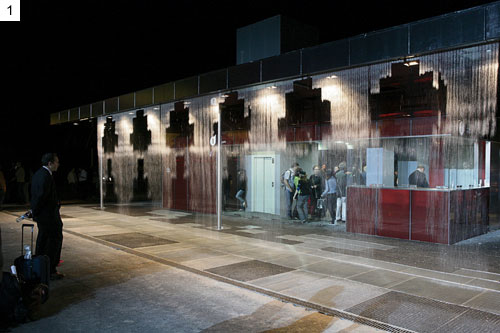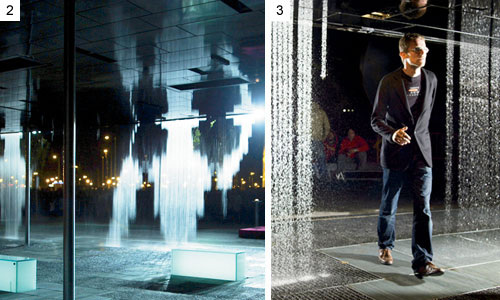Control Freaks
Learning Objectives:
- Explain the traditional role of building-control systems and how they are expanding to address new demands.
- Describe how sensor data can be visualized in architecture.
- Explain the advantages to both centralizing and decentralizing sensor technology.
- Identify future trends for building controls and sensing networks.
Credits:
There are 2,500 nozzles along the perimeter of the Digital Water Pavilion in Zaragoza, Spain. The nozzles contain solenoid valves and diffusers and sit at the edge of the pavilion's flat roof, greeting visitors with a liquid curtain. When you approach the pavilion, known as the DWP, a motion sensor in the roof detects your body and signals a processor in a digital control system to alter the solenoid valves at the individual jets of water that your body will displace as you walk through the curtain, just enough so you don't get wet. It's the type of architecture often produced for expos, such as the 2008 International Expo in Zaragoza, for which this was built, and it remains wildly popular with some visitors, even in its second incarnation as a café.
To the DWP's architect, Carlo Ratti, this water choreography represents nothing short of the next revolution in architecture - sensing. For Ratti, architecture cannot merely represent the machine or, in the case of the DWP, fluidity; it must either behave like a machine or become liquid. It's as if the glass on Mies van der Rohe's Barcelona Pavilion were dissolved into water and reimagined by some hyperkinetic gamers.
A typical Ratti project embraces the language of the digital age: interactivity, responsiveness, on-demand, pervasiveness, ubiquity, configurability. The DWP's water curtain not only parts for you, it can also be programmed to display an infinite number of patterns and images just by stopping and starting individual valves (the roof also raises and lowers to the ground, but that's another story). Ratti infuses these ideas into all of his projects. He recently proposed using Wi-Fi signals to track human occupancy of buildings to better tune mechanical systems toward providing more efficient heating and cooling. This last project is part of Ratti's work as director of the SENSEable City Laboratory at the Massachusetts Institute of Technology (MIT), but also informs his architectural practice, the Turin, Italy, and Boston-based Carlo Ratti Associati. Ratti's lab at MIT developed the DWP with the school's Design Lab and Smart Cities research group, directed by William J. Mitchell. "For architects, the only way to innovate will be to understand the basics of sensing," Ratti says.
 |
1. Preprogrammed patterns in the water are part of the pavilion's advanced controls system. |
 |
| Photos: © Max Tomasinelli (1); Carlo Ratti Associati (2, 3) |









